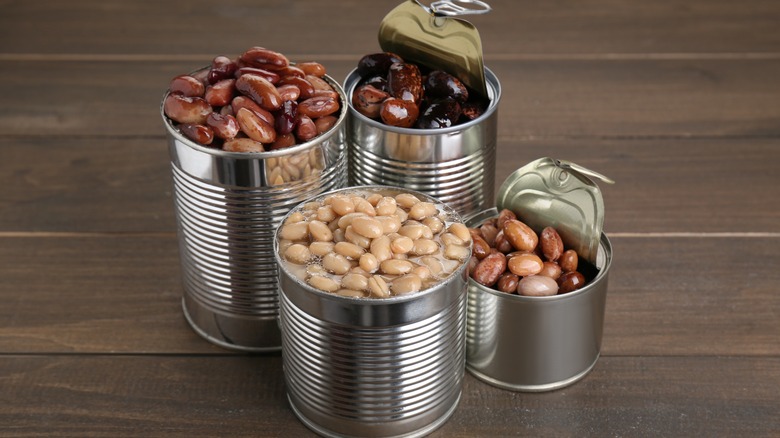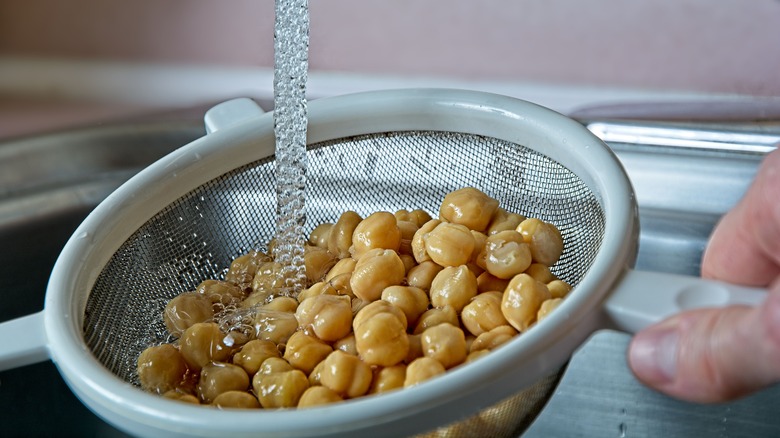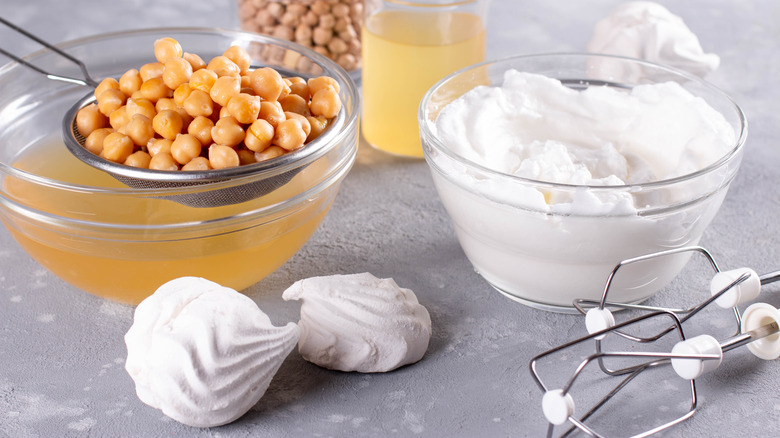We Finally Know Why Canned Beans Are Foamy When Rinsed
If you've ever opened a can of beans to make a batch of hummus, a pot of chili, or to add to a salad, you've likely noticed the presence of bubbly foam as soon as you start to rinse the beans with water. You might have even seen it floating on top of the cooking liquid if you've been cooking up a batch of dried beans from scratch. But what exactly is it, and why does it occur?
The foam that appears in your beans' rinsing water is made up of three components — proteins, starches, and saponins. These are all present in the beans, and when they're cooked and canned, they'll also infuse the liquid the beans are packed in. When agitated, such as when washing under running water or in a colander, they produce a lathery foam. Saponins in particular have soap-like foaming qualities, and among other things are used to make the frothy head on root beer — which is closely related to sarsaparilla soda — made from sarsaparilla root, a plant source for naturally occurring saponins. Aside from their food uses, saponins are used to make actual soap, detergents, shampoo, and toothpaste, as well as for industrial uses such as fire extinguishers.
Prevalent in legumes and beans such as chickpeas, soybeans, and green peas, saponins are also found in other plants foods, including oats, quinoa, alfalfa, sugar beet leaves, fenugreek, licorice root, ginseng, yucca, and saffron crocus ... the pretty purple flower we get saffron spice from.
To rinse or not to rinse
While its sudden appearance when rinsing beans might be a bit jarring, that foam is perfectly safe. Other saponin-rich foods you're likely already eating include asparagus, spinach, peanuts, eggplant, and broad beans (aka faba or fava beans). Furthermore, a 2024 study by the Journal of Medicinal Food has shown there are benefits of saponins on the immune system and the lowering of cancer risk, cholesterol levels, and blood glucose.
The foam itself is indeed harmless, but one of the huge mistakes you're probably making with canned beans is not rinsing them thoroughly enough. The bean liquid that comes from the can is often very high in sodium, and limiting how much sodium you consume is recommended to reduce the risk of cardiovascular disease and hypertension, as described in the government-issued Dietary Guidelines for Americans for 2020 – 2025. Allowing canned beans to first drain and then be rinsed will reduce their overall sodium content. Furthermore, not rinsing beans and using them straight from the can may make your food taste overly salty, and the foam can take on a bitter flavor, which will make its way into whatever you're cooking.
Beans are also well-known culprits for causing flatulence. This is mostly due to their fiber content, which along with protein, starch, and saponins will also pass through into the canned liquid. If you want to reduce the chances of going gassy or feeling bloated after eating a bunch of beans, give them a rinse.
Foamy bean water is a great egg substitute
Before rinsing foamy bean water down the drain, you might want to consider saving it instead. It turns out that this liquid has a very useful and magical vegan talent — when whipped, the frothy viscous water turns into an egg-free fluff called aquafaba. The same qualities that give beans a layer of foam when rinsed also give the fluid the ability to turn into a fluffy cloud of creaminess that can be used for so many different purposes. So, stop throwing out your chickpea water and use it as an egg substitute.
Slightly nutty chickpeas (also called garbanzo beans) are usually recommended for this purpose due to their mild flavor, but nearly any bean will work. Similar subtle-tasting beans like great northern and cannellini also work for when you don't want their flavor to be overwhelming, such as in desserts like meringue, mousse, whipped cream, custard, and pudding.
You can use aquafaba for savory recipes too where the taste of heartier beans may be welcome. Try saving the canned liquid from black, navy, or kidney beans for aquafaba. Their stronger flavors will complement things like salad dressing and dips. It's even possible to make mayo without eggs by replacing them with aquafaba. Just keep in mind that the color of the bean water will affect the final dish, so unless you don't mind dark mayo, stick with chickpeas except where darker hues won't matter — for example, in fudgy brownies.



